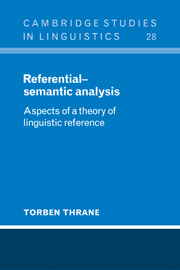1 - THE LINGUISTIC PRELIMINARIES
Published online by Cambridge University Press: 06 August 2010
Summary
Pronominalization
Among the clearly defined areas of contemporary linguistic research, that of pronominalization is the only one to subsume matters of reference in any consistent way.
There are two fundamental aspects involved in the linguistic analysis of pronouns. Although they are interrelated they call for a distinction which is not always clearly drawn. One aspect is concerned with the internal analysis of pronouns; another is concerned with the function of the pronouns in linguistic utterances. Moreover, it is not immediately obvious what the relationship between these two aspects is in inferential terms: can the internal make-up of pronouns be inferred from a consideration of the functions they (may) perform, or is the range of functions performed by a given pronoun dependent in some way upon its internal make-up? In the present section I shall enquire into these questions on the basis of a number of more-or-less recent treatments of the pronoun in the linguistic literature.
It would appear to be the case that within each aspect three different views are in contention. Thus within the functional aspect we can distinguish (I) ‘co-reference’, (II) ‘substitution’, and (III) ‘indication’; and within the aspect of internal composition, (A) their composition as NP, (B) as non-derived, and (C) as involving syncretism/segmentalization. These may not be absolutely clear-cut distinctions, particularly with respect to (A) and (C), and they may not cover the whole field of pronominalization.
- Type
- Chapter
- Information
- Referential-Semantic AnalysisAspects of a Theory of Linguistic Reference, pp. 7 - 21Publisher: Cambridge University PressPrint publication year: 1980



